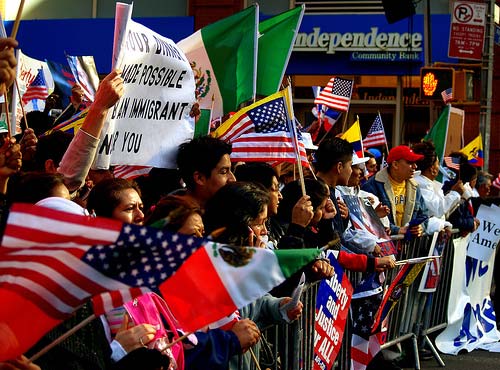I found the specific responses that the individuals writing the narratives had to their status as the Other particularly compelling. A unifying theme within the narratives was to refuse assimilating into American culture and instead to embrace their difference as an object of empowerment. Ramirez notes that he has “always had to deal with outsider status and I have accepted the benefits that come from it” (402). From my privileged position as a white-male-middle class-citizen, it is difficult to envision what types of benefits could be received from social exclusion. However, Ramirez reminds us that he has “never felt [his] identity was uncertain” (402). There is a clearly established boundary that establishes the Self for Ramirez, and he is always able to take refuge with this. Moreover, this identity is frequently empowering considering it can establish a sense of individuality. However, there is also a common theme of the need for solidarity within excluded communities. Andrade discusses the power of groups working together in order to “appear as a strong force against the white American society that always tried to oppress them” (410). I have a feeling that many individuals in our class would object to the radical rhetoric invoked by Andrade here. However, any negative response is merely the result of an incapability to utilize a sympathetic imagination in order to view the forces of racism in America. Keep in mind that Andrade is criticizing the oppressive forces of society that privilege white Americans, not the individual white Americans themselves. Whiteness has established a cultural hegemony that has infiltrated our understandings of beauty (as evidenced in the Bluest Eye), consumption habits (Ishmael reveals how our society ignores the plight of animals), and religion (eastern philosophies are stigmatized in light of Western Enlightenment and the religion of rationalism). Melendez also expresses concern about his identity, considering students knew him because he “was the only dark-skinned Latino among them” (417). In this way, Melendez attempts to assimilate within his school, but can never completely fit in.
 |
| machete provides a controversial depiction of migrant empowerment |
I believe that the theoretical category of the “abject” as outlined by Julia Kristeva is useful in explaining this point. For Kristeva, the abject is “something rejected from which one does not part.” Using a psychoanalytic framework, she notes that the abject is something that can never be completely banished from society, and instead its presence constantly challenges the existing social order. The United States was swept with immigrant protests in 2006 against Congressional threats of major crackdowns against immigrant societies. Nicholas De Genova likens these movements with the methodology adopted by queer political movements – “We’re here, we’re queer, get used to it.” The message was similar: “literally millions, abruptly altered the balance of forces, and migrants emerged as a force that could assert: We are here—in spite of our “illegality”” (De Genova 105). This is a type of obstructionist politics that “seeks not to be integrated within an existing economy of normative and normalizing distinctions, but rather to sabotage and corrode that hierarchical order as such” (De Genova 106). While one could respond to this analysis by claiming that the narratives are largely apolitical, I would argue that this is simply impossible. Their attempt to mediate their identities within a web of power-structures is intimately tied with political forces that determine which individuals are fit for society and which are not. All of the narratives feature an impossibility to fully integrate, and ultimately articulate an empowering result.
 |
| 2006 immigrant protests |
Nicholas De Genova. Center for the Study of Race, Politics, and Culture at the University of Chicago. 2010. “The Queer Politics of Migration: Reflections on “Illegality” and Incorrigibility”. Studies in Social Justice. Volume 4. Issue 2. Pages 104-106.


No comments:
Post a Comment